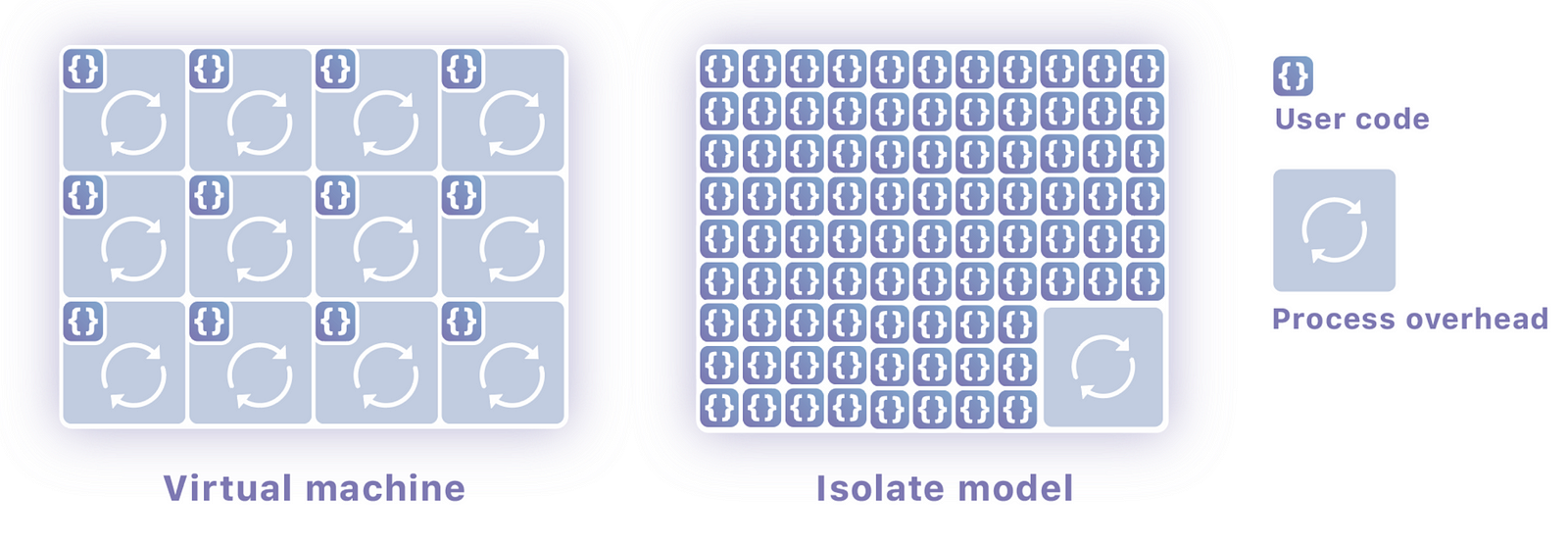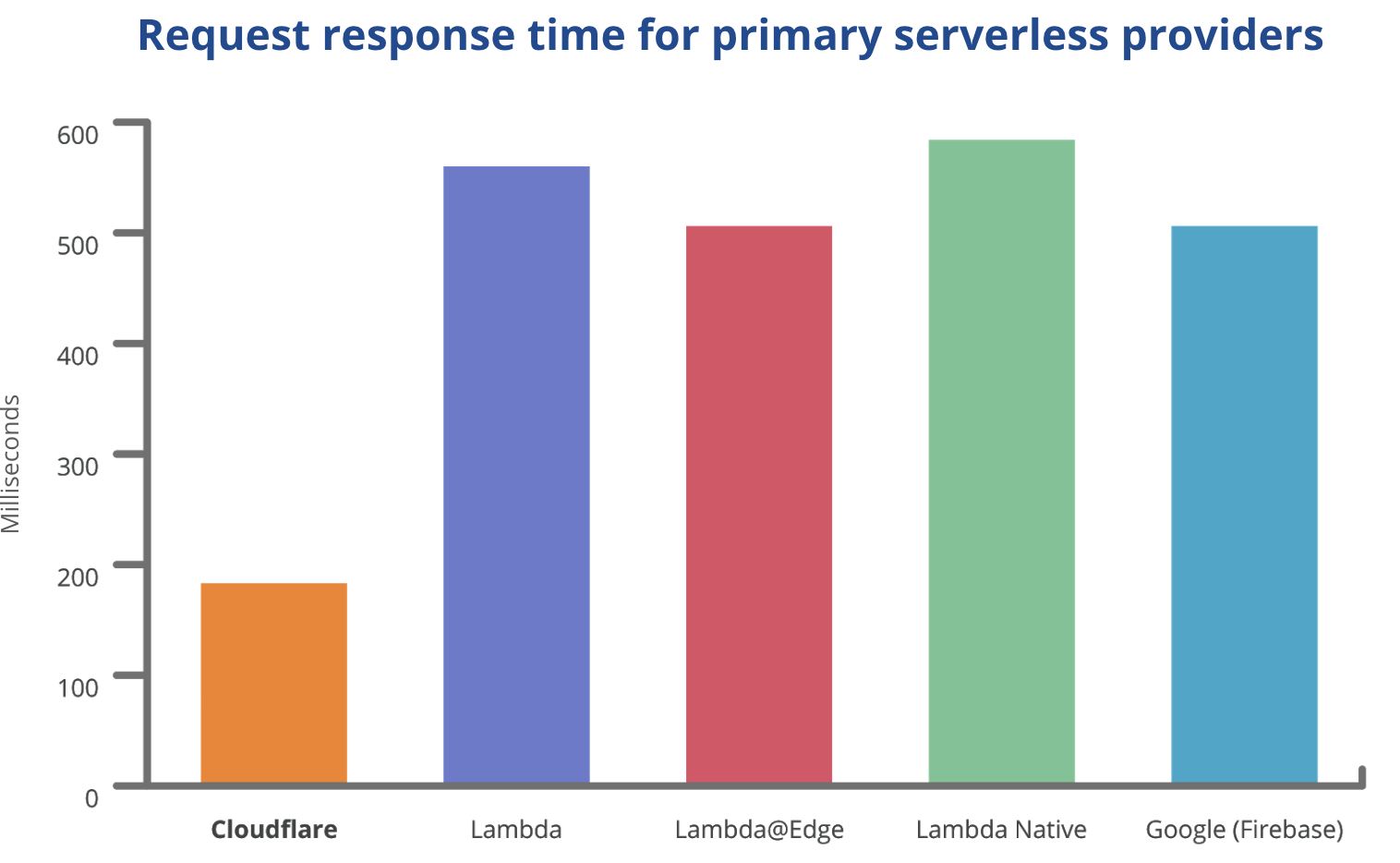Isolates are the Future of Cloud Computing
Cloud Computing Without Containers
I work on a cloud computing platform. Unlike essentially every other cloud computing platform I know, it doesn’t use containers or virtual machines. I think that is the future of Serverless and cloud computing in general, and I’ll try to convince you why.
(I’m a part of Cloudflare, where we have our
Isolates
Almost two years ago we set out to find a way to let people write code on our servers deployed around the world (we had a little over a hundred data centers then, it’s 154 as of this writing). We were dramatically limited in how many features and options we could build in-house and needed a way for customers to be able to build for themselves. We needed a way to run untrusted code securely, with low overhead. It also had to run very very quickly, as we sit in front of ten million sites and process millions and millions of requests per second.
The Lua we had used previously didn’t run in a sandbox, meaning customers couldn’t write their own code without our supervision. Traditional virtualization and container technologies like Kubernetes would have been exceptionally expensive for everyone involved. Running thousands of Kubernetes pods in a single location would be resource intensive, much less 154. Scaling them would be easier than without a management system, but far from trivial.
What we ended up settling on was a technology built by the Google Chrome team to power the Javascript engine in that browser, V8: Isolates.
Isolates are lightweight contexts which group variables with the code allowed to mutate them. Most importantly, a single process can run hundreds or thousands of Isolates, seamlessly switching between them. They make it possible to run untrusted code from many different customers within a single operating-system process. They’re designed to start very quickly (several had to start in your web browser just for you to load this web page), and to not allow one Isolate to access the memory of another.


We pay the overhead of a Javascript runtime once, and then are able to run essentially limitless scripts with almost no individual overhead. Any given Isolate can start around a hundred times faster than I can get a Node process to start on my machine. Even more importantly, they consume an order of magnitude less memory than that process.
They have all the lovely function-as-a-service ergonomics of getting to just write code and not worry how it runs or scales. Simultaneously, they don’t use a virtual machine or a container, which means you are actually running _closer_ to the metal than any other form of cloud computing I’m aware of. I believe it’s possible with this model to get close to the economics of running code on bare metal, but in an entirely Serverless environment.


Cold Starts
Not everyone fully understands how a traditional Serverless platform like Lambda works. It spins up a containerized process for your code. It isn’t running your code in any environment more lightweight than running Node on your own machines. What it does do is auto-scale those processes (somewhat clumsily). That auto-scaling creates cold-starts.
A cold-start is what happens when a new copy of your code has to be started on a machine. In the Lambda world this amounts to spinning up a new containerized process, and it can take between 500ms and 10 seconds. This means any requests you get will be left hanging for as much as ten seconds, a terrible user experience. As a Lambda can only process a single request at a time, a new Lambda must be cold-started every time you get an additional concurrent request. This means that laggy request can happen over and over. If your Lambda doesn’t get a request soon enough, it will be shut down and it all starts again. Whenever you deploy new code it all happens again as every Lambda has to be redeployed. This has been correctly cited as a reason Serverless is not all it’s cracked up to be.
Because we don’t have to start a process, Isolates start in 5ms, a duration which is imperceptible. Isolates similarly scale and deploy just as quickly, entirely eliminating this issue with existing Serverless technologies.
Context Switching
One of the key features of an operating system is it gives you the ability to run many processes at once. It transparently switches between the various processes which would like to run code at any given time. To accomplish that it does what’s called a ‘context switch’, moving all of the memory required for one process out, and the memory required for the next in.
That context switch can take as much as 100uS. When multiplied by all the Node, Python or Go processes running on your average Lambda server this creates a heavy overhead which means not all of the CPUs power can actually be devoted to running the customer’s code; it’s spent switching between them.
As an Isolate-based system runs all of the code in a single process and uses its own mechanisms to ensure safe memory access, there are no context switches.
Memory
The Node or Python runtimes were meant to be ran by individual people on their own servers. They were never intended to be ran in a multi-tenant environment with thousands of other people’s code and strict memory requirements. A basic Node Lambda running no real code consumes 35 MB of memory. When you can share the runtime between all of the Isolates as we do, that drops to around 3 MB.
Memory is often the highest cost of running a customer’s code (even higher than the CPU), lowering it by an order of magnitude dramatically changes the economics.
Fundamentally V8 was designed to be multi-tenant. It was designed to run the code from the many tabs in your browser in isolated environments within a single process. Node and runtimes like it were not, and it shows in the multi-tenant systems which are built atop it.
Security
Running multiple customer’s code within the same process is something which should, obviously, be done with a careful attention paid to security. I don’t think it would ever have been productive or efficient for us to build that isolation layer ourselves. The amount of testing, fuzzing, penetration testing, and bounties required to end up with something truly secure is astronomical.
The only reason this was possible at all is the open-source nature of V8, and it’s standing as perhaps the most well security tested piece of software on earth. We also have a few layers of security built on our end, including various protections against timing attacks, but V8 is the real wonder that makes this compute model possible.
Billing
This is not meant to be a referendum on AWS billing, but it’s worth a quick mention as the economics are interesting. Lambda’s are billed based on how long they run for. That billing is rounded up to the nearest 100ms, meaning people are overpaying for an average of 50ms every execution. Worse, they bill you for the entire time the Lambda is running, even if it’s just waiting for an external request to complete. As external requests can take hundreds or thousands of ms, you can end up paying ridiculous amounts at scale.
Isolates have such a small memory footprint that we, at least, can afford to only bill you while your code is actually executing.
In our case, due to the lower overhead, Workers end up being around 3x cheaper per CPU-cycle. A Worker offering 50ms of CPU is $0.50 per million requests, the equivalent Lambda is $1.84 per million.
The Network is the Computer
Amazon has a product called [email protected] which is deployed to their CDN data centers. I’m sure they’re doing their best with the technology they have to make it compelling, but it’s three times more expensive than traditional Lambda, and it takes 30 minutes to deploy a code change. I don’t think there’s a compelling reason to use it.
Conversely, as I mentioned, with Isolates we are able to deploy every source file to 154 data centers at better economics than Amazon can do it to one. It might actually be cheaper to run 154 Isolates than a single container, or perhaps Amazon is charging what the market will bear and it’s much higher than their costs. I don’t know Amazon’s economics, I do know we’re very comfortable with ours.
It long-ago became clear that to have a truly reliable system it must be deployed to more than one place on earth. A Lambda runs in a single availability zone, in a single region, in a single data center.
Disadvantages
No technology is magical, every transition comes with disadvantages. The biggest is an Isolate-based system can’t run arbitrary compiled code. In a world where you have process-level isolation your Lambda can spin up any binary it might need. In an Isolate universe you have to either write your code in Javascript (we use a lot of TypeScript), or a language which targets WebAssembly like Go or Rust.
If you can’t recompile your processes, you can’t run them in an Isolate. This might mean Isolate-based Serverless is something which is only for newer, more modern, applications in the immediate future. It also might mean legacy applications get only their most latency-sensitive components moved into an Isolate initially. The community may also find new and better ways to transpile existing applications into WebAssembly, rendering the issue moot.
Your Help
I would love for you to try Workers and let us and the community know what your experience is like. There is still a lot for us to build, we could use your feedback.
We also need engineers and product managers who think this is interesting and want to take it in new directions. If you’re in San Francisco, Austin, or London, please reach out.
